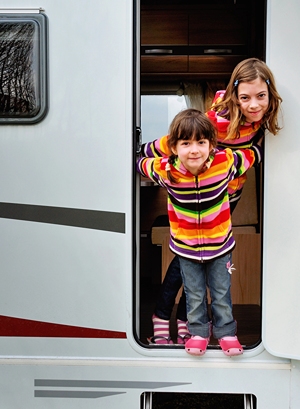From Seatbelts To Campsites: Comprehensive Kids Safety Tips For RV Trips
Embarking on an open-road adventure with kids is a fantastic way to make memories that can last a lifetime. But let’s be real — keeping the little ones safe from start to finish is priority number one. From buckling up to setting up a secure camp, following essential safety tips is key to having a great, low-stress trip.
Following some practical tips will help keep your kids safe on your next RV trip.
Buckle up
Your road trip starts with making sure everyone is safely strapped in. Every kid needs an age-appropriate car seat or booster seat. The National Highway Traffic Safety Administration (NHTSA) recommends keeping young children in a rear-facing seat until they’re at least two years old or outgrow it. Then, switch to a forward-facing car seat with a harness, and eventually, a booster seat until they’re big enough for a seat belt.
Be sure to check the harness fits snugly with the chest clip at armpit level and always make sure there’s room for everyone in the cab of the towing vehicle or the driver’s compartment in the RV.
Create a cozy environment
Your RV should feel as cozy and safe as home. Secure heavy objects and lock cabinets to prevent items from falling during travel. Use window shades to control the temperature inside and protect everyone from sun exposure. Set up a comfortable sleeping area for the kids, and keep the RV organized to make the journey smoother.
Set up camp smartly
Arriving at your campsite is when the fun begins, but safety remains key. Pick a family-friendly spot with flat terrain, away from water or cliffs. Do a quick check for sharp objects or poisonous plants. Create a safe play zone by setting clear boundaries with markers like ropes or cones.
Be ready for anything
Prepare for emergencies with a well-stocked first-aid kit. Include bandages, antiseptic wipes, pain relievers, tweezers, and any prescription meds. Know the nearest medical facilities and keep emergency contacts handy. Make sure your RV has a fire extinguisher and test your smoke and carbon monoxide detectors regularly.
Plan activities for all ages
Keeping kids entertained is key to a smooth trip. Pack toys, books, and games for younger children and plan regular stops to let them stretch and play. Choose outdoor activities that suit your children’s ages, such as nature walks for younger ones or hiking and kayaking for older ones. Always supervise to prevent accidents.
Adhere to strict food and water safety
Proper food and water safety are essential on your trip. Store food in airtight containers to avoid attracting wildlife and use your RV’s fridge to keep perishables cool. Follow basic food safety rules, such as using separate cutting boards for raw meat and vegetables and cooking meat to the proper temperature.
Bring plenty of bottled water or a water purification system for natural water sources and teach your kids to avoid drinking from unknown sources.
Read up on fire safety
Campfires are fun but require strict rules. Teach your kids basic fire safety, such as never playing with matches or lighters and keeping a safe distance from the fire. Use a designated fire pit and keep fires away from tents and RVs. Always have a bucket of water and a shovel nearby to fully extinguish the fire when you’re done.
Teach everyone about wildlife awareness
Wildlife encounters can be thrilling but also dangerous. Teach youngsters to keep a safe distance from animals and never to approach or feed them. Store food securely to avoid attracting wildlife to your campsite. If you’re in an area known for bears or other large animals, use bear-proof containers and follow recommended safety precautions.
Establish safety zones and emergency plans
Always keep a close eye on your kids, especially in unfamiliar or busy areas. Set up a designated meeting spot in case anyone gets separated during outdoor activities. For older kids, equip them with walkie-talkies or a whistle to use in emergencies. This helps them feel more secure and makes it easier to regroup quickly.
Go over outdoor survival basics
Empower your children by teaching them basic outdoor safety skills. Show them how to recognize poisonous plants, what to do if they encounter a snake or other wildlife, and the importance of staying within sight. Giving them these tools helps them stay safe while exploring new environments.
Adventure Awaits!
Successful family road trips are about more than just reaching your destination — they’re about the journey, the memories, and the fun you share along the way. By planning smart and keeping safety top of mind, every moment becomes part of the adventure. So buckle up, chart your course, and get ready for a road trip filled with laughter, exploration, and unforgettable family moments. The open road is calling!
Author Bio: Thomas Walden is the E-Commerce Manager at Parts Via, a supplier of auto and RV parts. Approaching two decades of experience in the automotive industry, Thomas specializes in bridging the gap between automotive and RV brands and retail outlets, leveraging a unique eCommerce sales network to reach consumers.













